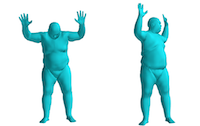Statistics on Manifolds with Applications to Modeling Shape Deformations
2013
Ph.D. Thesis
ps
Statistical models of non-rigid deformable shape have wide application in many fi elds, including computer vision, computer graphics, and biometry. We show that shape deformations are well represented through nonlinear manifolds that are also matrix Lie groups. These pattern-theoretic representations lead to several advantages over other alternatives, including a principled measure of shape dissimilarity and a natural way to compose deformations. Moreover, they enable building models using statistics on manifolds. Consequently, such models are superior to those based on Euclidean representations. We demonstrate this by modeling 2D and 3D human body shape. Shape deformations are only one example of manifold-valued data. More generally, in many computer-vision and machine-learning problems, nonlinear manifold representations arise naturally and provide a powerful alternative to Euclidean representations. Statistics is traditionally concerned with data in a Euclidean space, relying on the linear structure and the distances associated with such a space; this renders it inappropriate for nonlinear spaces. Statistics can, however, be generalized to nonlinear manifolds. Moreover, by respecting the underlying geometry, the statistical models result in not only more e ffective analysis but also consistent synthesis. We go beyond previous work on statistics on manifolds by showing how, even on these curved spaces, problems related to modeling a class from scarce data can be dealt with by leveraging information from related classes residing in di fferent regions of the space. We show the usefulness of our approach with 3D shape deformations. To summarize our main contributions: 1) We de fine a new 2D articulated model -- more expressive than traditional ones -- of deformable human shape that factors body-shape, pose, and camera variations. Its high realism is obtained from training data generated from a detailed 3D model. 2) We defi ne a new manifold-based representation of 3D shape deformations that yields statistical deformable-template models that are better than the current state-of-the- art. 3) We generalize a transfer learning idea from Euclidean spaces to Riemannian manifolds. This work demonstrates the value of modeling manifold-valued data and their statistics explicitly on the manifold. Specifi cally, the methods here provide new tools for shape analysis.
| Author(s): | Oren Freifeld |
| Year: | 2013 |
| Month: | August |
| Department(s): | Perceiving Systems |
| Research Project(s): |
Learning on Manifolds
|
| Bibtex Type: | Ph.D. Thesis (phdthesis) |
| Paper Type: | Technical Report |
| School: | Brown University |
| Links: |
pdf
|
|
BibTex @phdthesis{Freifeld:Thesis:2013,
title = {Statistics on Manifolds with Applications to Modeling Shape Deformations},
author = {Freifeld, Oren},
school = {Brown University},
month = aug,
year = {2013},
doi = {},
month_numeric = {8}
}
|
|


